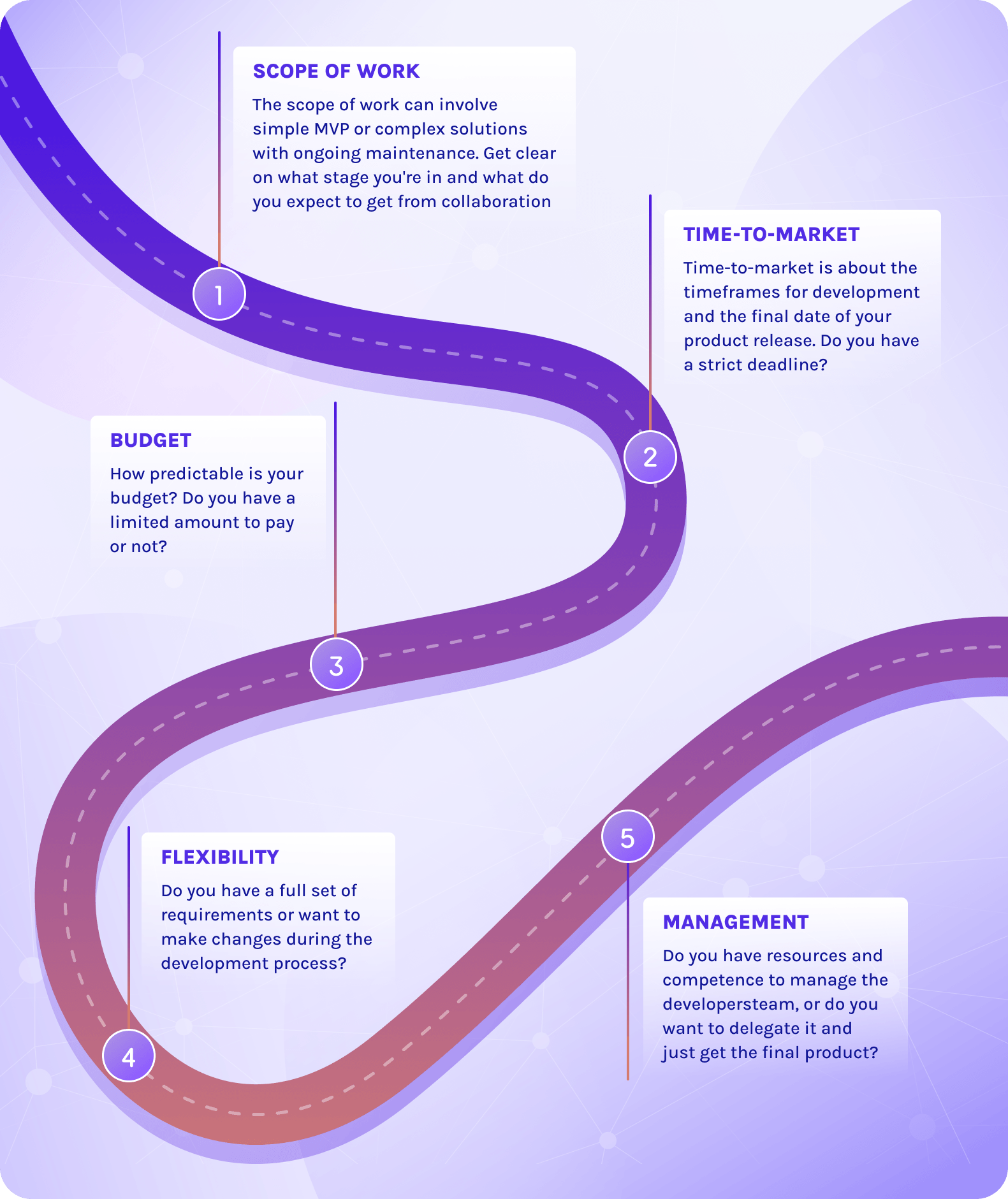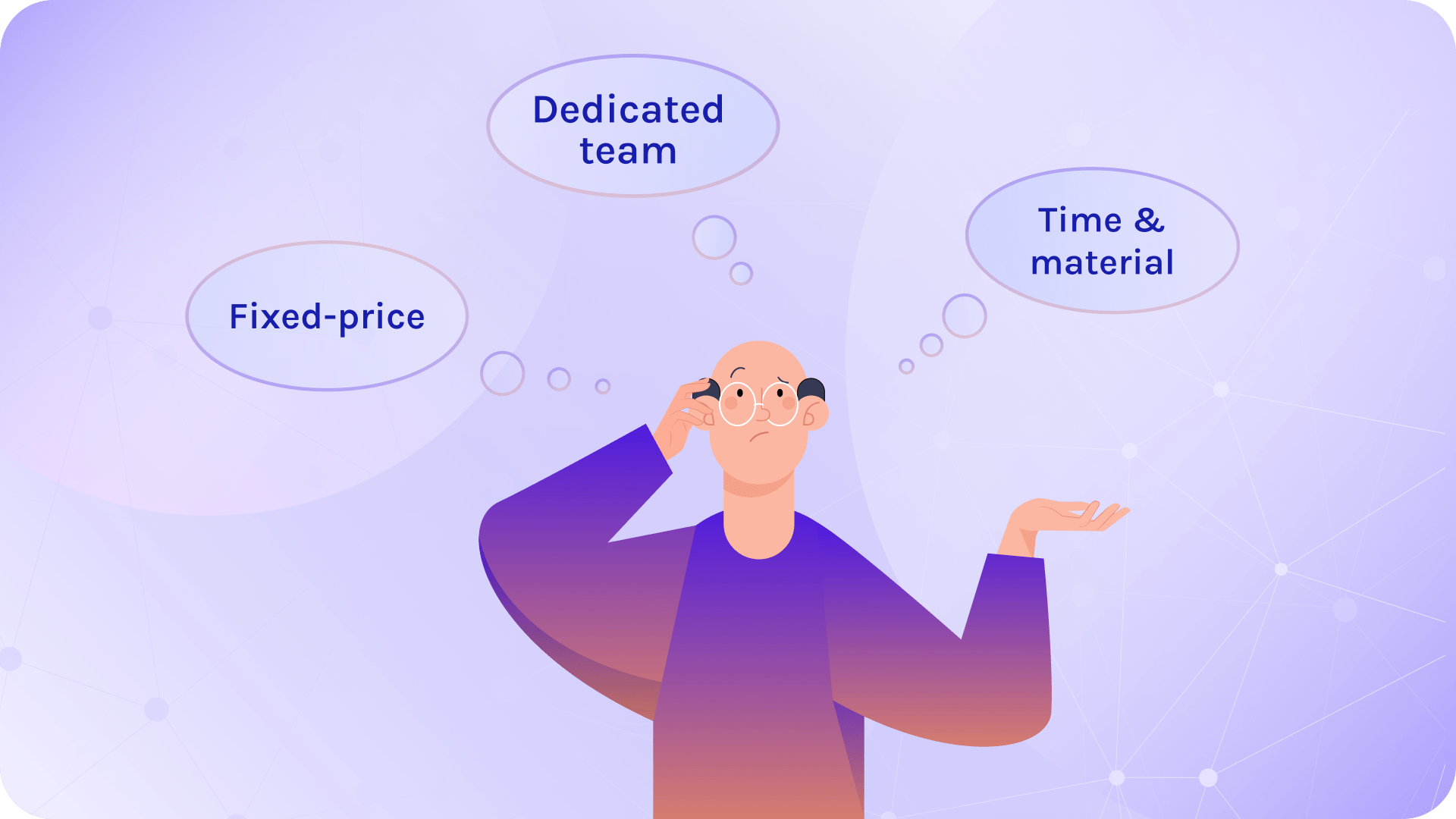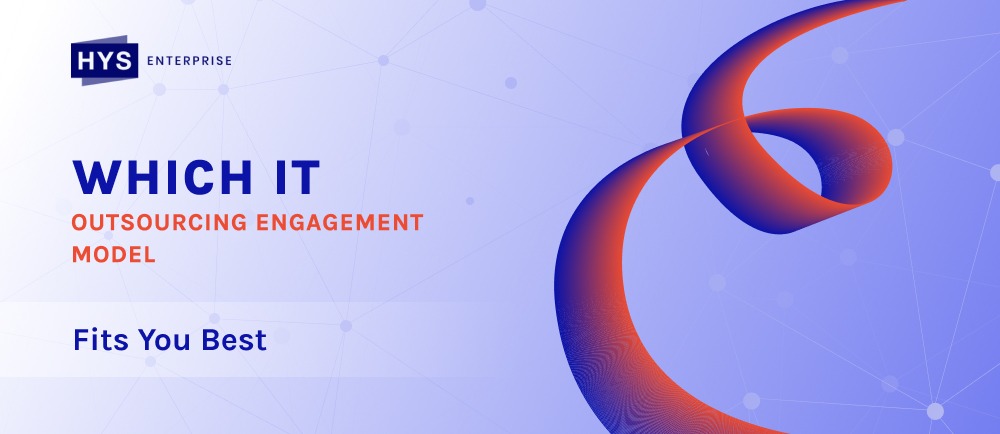The engagement model is the framework that defines the relations between you and the vendor you chose. It helps to get the maximum from your partnership and set up the level of client control, project flexibility, and how payments are dealt with.
Before Digging In
Before choosing the way you want to cooperate with your outsourcing partner, you should sort out a few things about your project and your goals:
- Scope of work
- Flexibility and time-to-market
- Budget
- Management
The scope of work can involve simple MVP or complex solutions with ongoing maintenance. Get clear on what stage you’re in and what do you expect to get from collaboration. It’ll help to choose the engagement model that pans out.
The flexibility of your project development determines whether you have an exact requirement for the project, what features must be, and how they should be implemented. Or that’s all discussable and you want to have a chance to add or change them. Time-to-market is about the timeframes for development and the final date of your product release. Is it strict or floating?
Also, you have to understand how much you’re going to pay and how predictable your budget should be. And last but not least, do you have resources and competence to manage the developers’ team, or do you want to delegate it and just get the final product? There is also a scenario where you have your core team with developers or managers and want to hire a dedicated team to strengthen your capabilities.

Milestones before choosing an engagement model. You can download this infographic here.
So let’s assume you already know all these nuances and figure out what type of cooperation will fit you best. 
Dedicated team
A dedicated team means that you ‘rent’ the required team of professionals for your project. You can hire not only developers but also QA engineers, project managers, or designers. You can choose specialists with qualifications to fit your project best. So it gives you a lot of flexibility to create whatever you need.
As you hire the team you define the scope of work, requirements, and development directions. It means that you should be ready to manage the team and have responsibility for your project’s process.
The plus of this model is a predictable budget. You pay a salary for your team every month and the vendor’s fee. The vendor’s fee includes costs on offices, hardware, HR processes, sick leaves, day-offs, etc. So you have a fully equipped team that is ready to work with you. If you need to scale up or shrink your team, you can discuss it with your vendor. It allows your project to quickly adapt to any new requirements or changes.
Strengths of the Dedicated Team Model
-
A focused team
The project team remains highly focused on the plan’s specific objectives and desired outcomes. This concentration aids in eliminating unnecessary activities and channeling all efforts towards successfully completing the project.
-
Faster deployments
With experts from diverse backgrounds, the dedicated team enables quicker and more efficient deployments, ensuring swift progress.
Weaknesses of the Dedicated Team Model
- A factor to consider about the vendor’s project management role is that they don’t have much control over how the development process moves forward. To make sure the service that you want will be provided, they need clear and detailed descriptions of tasks.
- Frequently, you’ll need to share sensitive business information with an outside party to help them grasp your business and goals better. So, it’s important to choose a vendor with good reviews and have legal experts create NDAs to keep things confidential.
What project type is preferable for a dedicated team model?
“
This engagement model fits for long-term projects as it offers a stable team to deliver the client’s needs. The client can choose the resources and qualifications of engineers. Also, he can motivate the best performers.
The main pros of a dedicated team are direct communication between both sides — the client and suppliers. Usually, the work process is extremely flexible and the client manages all the requirements and timelines.
Infrastructure for development is usually on the client’s side. Another plus is the opportunity to fully implement Scrum and Agile.
”
Kateryna Martyn, PM at HYS Enterprise
Team Augmentation
Furthermore, you can not only “rent” a team, but also get extra hands when needed. It’s called team augmentation. It’s a simple way for companies to add temporary outside workers to their existing team. This is a good way to save some money. It can work well for short-term projects, but the company needs to look after the added employees. The company’s own managers and leaders still control the important parts of the project, while tasks like development or testing can be done by the added outside staff. Since augmented team members are usually hired for their expertise, they can often start contributing in projects more quickly than new full-time employees who need more time to get into.
However, the added workers don’t often bring creativity and ideas into the team simply because they have limited responsibilities and aren’t encouraged to come up with new things.
Strengths of Team Augmentation
-
Cost savings
Utilizing augmented teams can result in reduced costs compared to hiring new staff or managing outsourced operations. This approach saves both money and time, as it provides access to resources for a shorter duration without the need for permanent hiring.
-
Resource flexibility
Augmented teams offer the advantage of easy scalability. Adjusting staff numbers can be a slow and resource-intensive process, but with augmented team members available on demand, businesses can efficiently manage team size based on current needs.
-
Progress visibility
With development kept in-house through augmented teams, communication with the business becomes quicker and more effective. This enables the team to keep stakeholders updated on progress and promptly address any challenges that may arise.
Weaknesses of Team Augmentation
-
Coordination complexity
Managing a mixed team of in-house and outside staff can be tangled, requiring efficient communication and project management strategies.
-
Dependency on external providers
Heavily relying on external staff can lead to dependence on the capabilities and availability of the outsourcing vendor, including your flexibility and control over project resources.
-
Limited innovation
Augmented team may not be as invested in driving innovation within your company compared to your core in-house team.
Fixed Price
A fixed price model is a classic one where the client approves the budget and pays exactly according to it. All requirements should be discussed and agreed upon in the contract. It means that you have to know all you need for your project in advance. Transparent communication between the client and the supplier is the most significant part. It determines the scope of work you need in every detail and a fixed deadline. So the more questions you discuss with your vendor the better.
Mostly the cooperation in this model starts with setting all requirements for the project: detailed description of any feature or design. Then the Request for proposal (RFP) is prepared. It includes all specifications and details that you discuss with your vendor. Then you receive an offer of implementation with the final scope of work in detail, delivery schedule, and payment.
Strengths of the Fixed-Price Model
-
Accurate budget
The project initiates once an established and mutually agreed-upon budget is in place. The client possesses a clear understanding of the unchanging budget throughout the project’s entirety.
-
Guaranteed outcomes
The scope of work remains precisely outlined and undergoes no alterations until project culmination. Additionally, the agreement can include provisions for penalties in case of tardy deliverables, ensuring the client’s protection.
-
Transparent workflow
Both the client and the outsourcing company agree on the direction of the work and its progress during the term.
Weaknesses of the Fixed-Price Model
-
Lack of flexibility
The fixed-price contract makes it challenging to accommodate new requirements or adapt to changing market conditions. Any modifications typically require another agreement to be signed.
-
Long planning process
Due to the need for a comprehensive understanding of all requirements upfront, the fixed-price model demands detailed discussions and extensive planning, leading to time-consuming preparations.
-
Uncertainty for difficult project
Complex projects or those using new technologies can bring a lot of uncertainty. In these cases, a fixed price model might not cover the unexpected problems and difficulties that can come up.
What project type is preferable for a fixed-price model?
“
On the contrary to the previous model, this one is suitable for short term projects. Requirements have to be exactly described so it takes more time for preparation before starting the project.
Everything that was not described and included in the scope could not be done without a change request. The hardest part for the client is to prepare the full set of specifications and requirements for the project. Once it’s done and approved, the client can be less engaged in the development process. So the client usually knows only the price but is not aware of resources.
The cons include less flexibility because of budget limitations. Scrum can not be fully implemented.
”
Kateryna Martyn, PM at HYS Enterprise
Time & Material
Time and material is a flexible engagement model where you pay only for the time developers spend doing necessary tasks. You don’t have to set strict deadlines and requirements. Before starting, the client shares the main idea of the product and which features should be implemented. Then it’s split into user stories and estimated.
If the fixed price model needs full-scale preparation with a clear description of all products, budget, and deadline, then the time and material model doesn’t need it. It makes it easier to start. Also, you can change the requirements or add new features freely. The development goes in iterations and after which one you can discuss any changes you want to implement. It’s a good point in the evolving market.
If you run out of the budget, you can stop the development and get a ready product on the stage as it is. Speaking about management, you should be ready to be involved in iterations and take part in the whole process constantly. The flexibility of this model allows the team to use Agile practices such as Scrum, Kanban, etc.
Strengths of Time & Material Model
-
Cost-efficiency
T&M can be cost-efficient for projects where the scope is uncertain or likely to change. Clients only pay for the actual hours worked and used resources.
-
Rapid start
This model allows projects to start quickly since there is no need for extensive planning. It is particularly useful for projects with urgent timelines.
-
Highly Agile
T&M is well-suited for Agile project management methodologies, where continuous iteration and adaptation are vital.
-
Suitable for complex projects
For projects that involve a high level of complexity or uncertainty, the T&M model provides the flexibility needed to handle these challenges effectively.
-
Resource allocation optimization
Service providers can allocate resources based on the project’s current needs, furnishing ideal utilization of skilled professionals.
Weaknesses of Time & Material Model
-
Budget planning complexibility
You can hardly estimate the end price of the project because of the changes.
-
Unclear deadlines
Since the scope of the project is not clear, you can not measure how much time the development process will take.
-
Regular communication with the vendor
While choosing this model, your constant involvement in the development process will be needed as you’ll have to approve the proposed changes.
What project type is preferable for a time & material model?
“
The Time & Material model is preferable for midterm projects. After a ballpark, each task needs to be estimated and the client has to approve it.
There is a place for changes without finalizing the complete scope. The budget is always under control. So this one is a balance between a dedicated team and a fixed price.
”
Kateryna Martyn, PM at HYS Enterprise
Can I change the engagement model when the collaboration is already started?
Yes, it is possible. Usually, that happens when we work with startups. They always have a certain budget to kickstart their idea, so fixed-price contracts are preferable for them. Afterward, when they find investors or collect first revenue, they look more into either a long term dedicated team or a time & material engagement.
Another good example of where the engagement model usually changes is when the project needs to be fully finished. In this case, clients usually ask for support and maintenance of the project and the engagement model can change either to a fixed-price or time & material (monthly payments for a certain amount of hours) which is more flexible.
How do outstuffing differ from the mentioned engagement models?
Outsourcing or outstaffing – that is always a hard decision for the clients. The main difference is that the client pays for the full delivery of the project in the outsourcing model and the outstaffing means that the client pays for the employees.
Outstaffing is a process where the client ‘hires’ an employee of another company to its company. It is a good decision when a client already has established good development processes or even an in-house team. In this case, he has full control over every asset of his team and on the development process.
In today’s business world, working together through partnerships is crucial for growth and innovation. Association allows businesses to combine their strengths and resources, leading to shared success.
Let’s consider some types of partnerships, where organizations join forces to use each other’s capabilities. We’ll look at how collaborations bring multiple benefits and opportunities for companies.
Partnerships
Organizations have an opportunity to establish partnership agreements with the aim of progressing and expediting the realization of shared objectives. Instances of this include capitalizing on a partner’s assets like professional services or customer base, jointly pursuing significant projects, accessing novel markets, and more. Here is even greater information about this subject:
-
Utilizing partner’s resources
Organizations can enter into partnership agreements to mutually benefit from each other’s resources, such as professional services or client base.
-
Joint participation in major projects
Two or more organizations can combine efforts to collectively undertake a significant project. This could involve a shared investment of financial resources, manpower, and expertise to achieve a common goal.
-
Technology and knowledge exchange
Partnerships can encourage the exchange of technologies, innovative solutions, and knowledge between organizations. This can accelerate the development and implementation of new products or services.
-
Branding synergy
Two or more organizations working together on a specific project or initiative can enhance their brand value and gain greater public recognition.
Co-development
Certainly, organizations can collaborate on the creation and growth of innovative products or transformative offerings through investment and co-develop agreements. This entails shared ownership of intellectual property (IP), commercial rights, and responsibilities. Let’s dive into additional insights:
-
Collaborative innovation
When organizations join forces to invest and co-develop a new product or service, they pool their resources, expertise, and creativity. This collaborative approach often leads to the generation of innovative ideas and solutions that might not have been achieved on their own.
-
Shared Intellectual Property (IP)
In such partnerships, the participating organizations jointly contribute to the development process, which can result in co-ownership of the intellectual property rights associated with the product or offering. This means that both parties have a stake in the IP and can use it for future innovations or business opportunities.
-
Market access and expansion
Co-developed products may provide occasions for both organizations to access new markets or customer segments that either party couldn’t reach on themselves. This expanded market reach can lead to increased revenue and growth potential.
-
Long-term partnership
Collaborative product development can strengthen the relationship between organizations, potentially leading to long-term partnerships. The success of co-developed products can consolidate trust and do the first step for future joint ventures.
If you’re looking for a team to deliver your projects, HYS Enterprise is your solution. For more than 16 years we effectively engage across all three models and use Team Augmentation, Partnership, and Co-Development to give seamless results to our clients. Our experts can guide you in pinpointing the most suitable engagement model according to your business needs and goals. We have realized hundreds of projects across diverse industries operating with different outsourcing methods. Don’t hesitate to Contact Us to discuss the engagement models and your next project. We’ll be happy to Help You Succeed.
